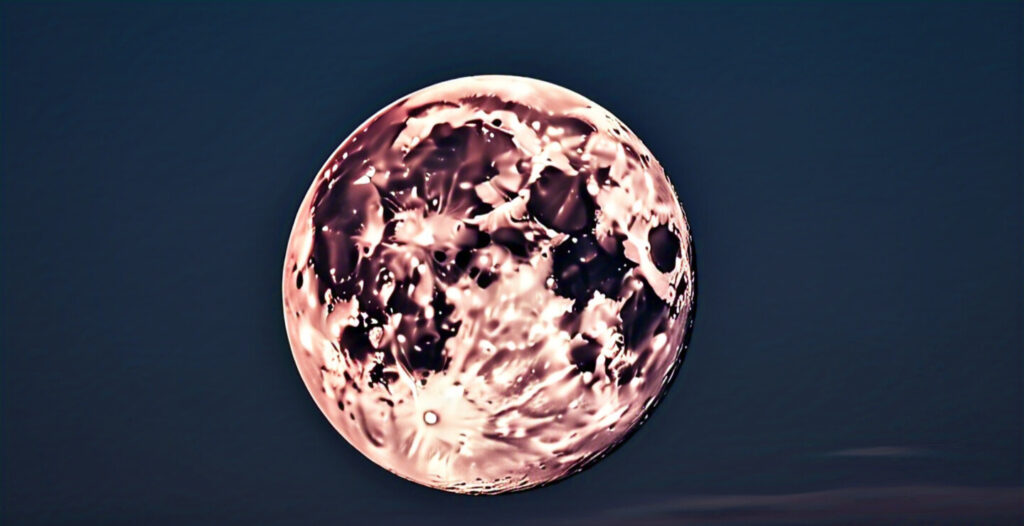Strawberry Moon 2025: Lowest Full Moon in Decades Rises June 10–11
By Kashmir News | Published: June 11, 2025
The Strawberry Moon 2025, a rare celestial event, illuminated the night sky on June 10–11, 2025, as the lowest full moon in nearly two decades. This phenomenon, caused by a major lunar standstill, won’t occur again until 2043, making it a once-in-a-generation spectacle, as detailed in a BBC Sky at Night Magazine report. Named after the Native American strawberry harvest season, the moon appeared larger and redder due to its low position, captivating skywatchers globally. This article explores the event, its significance, and tips for viewing. For more science news, visit our Technology section.
What Makes the Strawberry Moon 2025 So Special?
The Strawberry Moon, June’s full moon, is named for the ripening of wild strawberries in North America, as explained in a CNN article. In 2025, it stands out due to a major lunar standstill, a rare event occurring every 18.6 years when the moon’s orbit tilts at its maximum, causing it to rise and set at its most extreme points on the horizon. A Space.com article notes that this results in the lowest full moon since 2006, appearing just 10 degrees above the horizon in some regions. The low angle scatters blue light, giving the moon a golden or reddish glow, as highlighted in an Economic Times report. For more on astronomy, explore our Technology section.
The moon reached peak illumination at 3:44 a.m. ET on June 11, 2025, but was best viewed at dusk on June 10, rising over the southeastern horizon, per a Live Science article. Social media buzzed with excitement, with posts on X describing it as “a must-see event” due to its rare low trajectory.
Key Details of the Strawberry Moon 2025
This lunar event combines cultural significance with astronomical rarity. Below is a table summarizing key details:
| Aspect | Details |
|---|---|
| Date | June 10–11, 2025 |
| Peak Illumination | 3:44 a.m. ET, June 11, 2025 |
| Best Viewing Time | Dusk, June 10, 2025 (southeastern horizon) |
| Event | Major lunar standstill (lowest full moon since 2006) |
| Next Occurrence | 2043 |
| Appearance | Golden or reddish glow, larger due to low position |
| Name Origin | Native American strawberry harvest season |
Why Is It Called the Strawberry Moon?
The name “Strawberry Moon” originates from Native American tribes, particularly the Algonquin, who associated June’s full moon with the ripening of wild strawberries, as detailed in an NDTV article. Other tribes, like the Anishinaabe and Sioux, call it the Berries Ripen Moon, reflecting the season’s abundance. Despite its name, the moon doesn’t appear pink but may glow reddish due to its low position, as light passes through denser atmospheric layers, per a Yahoo report. For more on cultural traditions, visit our Lifestyle section.
The Major Lunar Standstill Explained
The major lunar standstill occurs every 18.6 years when the moon’s orbital tilt reaches its maximum, causing it to rise and set at its most extreme northern and southern points. An Evening Standard article explains that in 2025, this results in the lowest full moon in the Northern Hemisphere, not seen this low since 2006. After 2025, the moon’s path will shift, with the next such event in 2043, per a Dallas News report. This rare alignment makes the Strawberry Moon a prime opportunity for astrophotography, as captured by photographers like Paolo Palma in Italy, per BBC Sky at Night Magazine.
How to View the Strawberry Moon 2025
To catch the Strawberry Moon 2025, find a location with a clear southeastern horizon, away from city lights, as advised in a Times of India article. The moon rises just after sunset on June 10 and is visible through the early hours of June 11. In India, optimal viewing is post-sunset on June 11, per an NDTV report. No telescope is needed, but binoculars enhance details. Clear skies are forecast for many regions, though clouds may obscure views in areas like Texas, per a Dallas News article. For stargazing tips, check our Technology section.
The moon appears full for three days, from June 10 to 12, per a KGW article. Its proximity to the star Antares in Scorpio adds a striking backdrop, as noted in a Yahoo report. Photographers should capture it at dusk for the best reddish glow, as seen in images from Central Georgia, per a 13WMAZ report.
Global Reactions and Cultural Significance
The Strawberry Moon 2025 sparked global excitement, with astrophotographers sharing stunning images, such as Sharon MacPherson’s shot from Scotland, per BBC Sky at Night Magazine. Posts on X called it “a cosmic treat,” with users urging others to “look up tonight!” In Australia, the moon appeared higher, the highest full moon since 2006, due to the Southern Hemisphere’s perspective, per a Sydney Morning Herald report. Spiritually, the moon in Sagittarius inspired themes of adventure and manifestation, per a Marca article. For more on global events, visit our Breaking News section.
Don’t Miss This Celestial Event
The Strawberry Moon 2025 is a rare opportunity to witness a low-hanging, golden moon, not to be seen again until 2043. Whether you’re a stargazer or casual observer, head outside on June 10–11 to enjoy this spectacle. Stay informed with Kashmir News for more astronomical updates. Explore our Entertainment, Sports, or Business sections for other stories.


